Studio Lighting Equipment and Techniques
Studio Lighting.
Light is critical to the TV picture because it is what the TV camera sees. The quality of the light falling on the subject is directly related to the quality of light which will be reflected into the camera lens.
Light has 3 properties which are of concern to the TV producer:
l. Intensity. This involves the amount of light present and is measured in footcandles using an incident (direct reading) light meter. In general, the more light the better the picture, although modern cameras produce usable pictures in very low light.
Intensity can be controlled by:
a. dimmers- however they cause a color shift and can be used for only minor control and special effects.
b. distance- the inverse square law states that light intensity varies with the square of the distance between light and object, so moving the light in the studio is the easiest and quickest way to make major changes in intensity.
c. scrims- these are color neutral screens which can be placed over a light to reduce its intensity. Steel window screen works well, but in the studio we tend to use spun fiberglass. Wasteful of light, however.
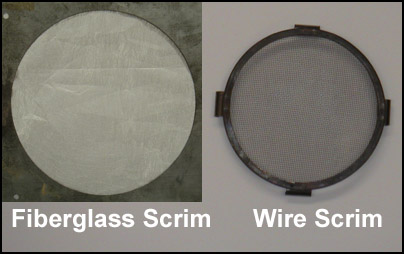
d. spot-flood controls- these spread the light from an instrument out or concentrate it in a small area. Since we are usually only concerned about a small area, such as a talent's face, these controls work well to adjust the intensity in this area. Spill light is controlled by barn doors, flat black flaps on the front of the light which absorb any unwanted width of the beam.
2. Coherence (polarity). This is the degree to which the light particles (Photons) are parallel with each other when they leave the light instrument. Perfectly polarized light is a laser, however in TV we use light which is slightly polarized (coherent) to cast clean, hard shadows (spot lights), and light which is unpolarized (diffuse) to soften these shadows (flood lights).
3. Color. While we may use lights with colored gels for special effects, we try to keep all colored light off of faces in TV to prevent viewers from constantly adjusting their TV sets. All white light, however, has a tint to it. The eye adjusts to this, but the camera cannot. We must tell the camera what is white (white balance) and do this every time we change lighting conditions.
We measure the tint of white light (called color temperature) with a unit called the degree Kelvin. This is the temperature in absolute degrees of a steel bar which glows at the different colors. The higher readings are the bluer colors. Sunlight which is very blue is approx. 5600 degrees K at noon on a clear day. Studio lights are relatively redder and are standardized at 3200 degrees K.
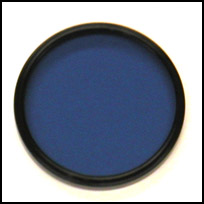
A Color Temperature Blue (CTB) gel needed to match studio lights to sunlight.
When using colored gels for effect, remember to white balance on WHITE light. Otherwise the color effect will be lost.
There are two basic approaches to using lights to create good TV pictures.
l. The older system is called the base light system. In this system an even base light level is established using flood lights. The key parts of the scene are then highlighted with spot lights. This is still used and works well when talent move around a lot as in dance numbers. Also appropriate for game shows.
2. The photographic system comes to TV from the earliest portrait photographers, however early TV cameras could not handle the contrast range inherent in this system. This system is explained in detail in the handout Three-Point Lighting in the TV Studio.
The Lowell Lighting Co. has some fascinating interactive lighting plans available at Lowell.com/edu. These plans allow the user to move lights around a virtual subject and see the resulting images.
Some lighting directors prefer to look at good lighting as manipulating the shadows, as these are what give objects their form. Falloff is a term for how the lighted areas shade into the shadow areas. Fast falloff makes for very contrasty pictures, while slow falloff is more subtle.
There are two special effects lighting techniques which are commonly used.
l. Cameo- in this type of lighting the subject appears brightly lighted against a black background (high contrast, fast falloff). It is accomplished by preventing any light from spilling on the background which should be fairly dark to begin with. To achieve this, move the talent out from the background, use steep key light angles, and use flooded spot lights for fill. Barn doors should be used to keep spill light off the background. Cameo is effective at concentrating attention on the subject.
2. Limbo- in limbo lighting we try to obscure the horizon line so that the subject seems to be floating in air. We use very diffuse flood lighting (low contrast, slow falloff) and a seamless backdrop rolled out on the floor.
Instrument Types.
Spotlights:
l. Fresnel spotlight- the basic spot used in TV. Operated by moving lamp and reflector forward for flood and back for spot. Pronounced (Fre-nel) with the "s" silent!
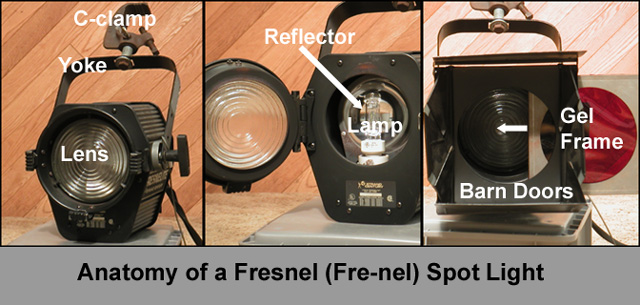
2. Elipsoidal spotlight (Leko)- these are very hard (coherent) spots used in theatre. They are used only for special effects in TV.
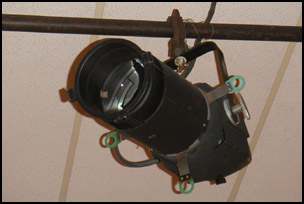
Elipsoidal Spotlight
3. External reflector spotlight- these spots have no lens and therefore are lighter and less bulky than fresnel spotlights. Their beam is slightly more coherent and less even from edge to edge with a slight "hot spot" in the middle, however they are excellent for use in portable light kits.
Floodlights:
l. Scoops- these icecream scoop shaped lights provide good basic flood light.
2. Broads- these are square flood lights which are slightly harder (more coherent) than scoops, but light large areas.
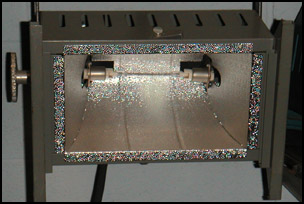
Television Broad
3. Set lights- broads with a specially shaped reflector which directs most of the light down to illuminate the bottom of the background. To work correctly they must be hung with the lamp at the top and at approximately a 45 degree angle to the set.
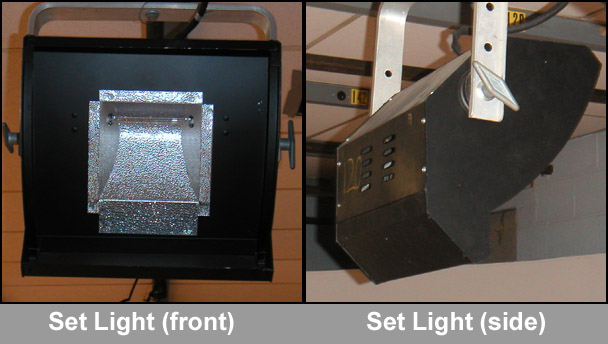
Lamp Types.
Most modern TV lights use quartz halogen lamps which are smaller, more color constant, and cast about 3 times the light for the same amount of electricity as their tungsten equivalents. These lights get very hot so take precautions when handling them.
When mixing TV lights with sunlight, HMI lamps may be desireable. They are quite expensive, but burn at the same color temperature as sunlight and put out about 3 times the light intensity of quartz lamps.
Operation of Lights.
l. Always unplug the instrument before handling.
2. Avoid overloading circuits.
3. Never turn on an unshielded light while it is pointed at someone.
4. Don't touch the quartz lamps.
5. Avoid burning yourself on hot instruments.
6. Always use safety chains!!!
7. Don't over-tighten C-clamp. It can break.
8. Loosen pan bolt to rotate instruments.
9. Check that yoke bolt is tight after adjusting instruments.

C-clamp & lighting instrument

Return to TVR 055 Home Page







